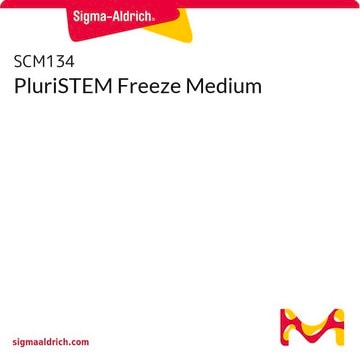CC131
Stem Cell Qualified ECM Gel
Stem cell qualified basement membrane extract (BME) for human ES and iPS cell culture.
Synonym(s):
Basement membrane extract (BME)
About This Item
Recommended Products
form
gel form
technique(s)
cell culture | stem cell: suitable
General description
NOTE: Expansion of human pluripotent stem cells requires culture ware that is coated with prequalified ECM proteins. Below are general guidelines for the coating of 6-well plates using the Stem Cell Qualified ECM Gel (CC131). All procedure should be performed under aseptic conditions in a biological safety cabinet.
1. Thaw the Stem Cell Qualified ECM Gel in the 2-8°C fridge one day before use. Once thawed, maintain ECM Gel on ice at all times and use pre-cooled medium and pipettes to avoid gelling of the product.
IMPORTANT: Do not thaw ECM Gel at temperatures higher than 15ºC to avoid gelling.
2. Dilute the ECM Gel 1:80 with cold DMEM/F12 (D6421) medium. Scale up or down according to the volumes required. Below is an example for coating a 6-well plate with 1.5 mL of 1:80 diluted ECM Gel.
• To make a 1:20 dilution, add 0.5 mL ECM Gel to 9.5 mL cold DMEM/F12 (D6421) or DMEM (D5796) medium into a 15 mL conical tube. Total volume = 10 mL.
• A further 4-fold dilution is required to make the final 1:80 dilution. Add 2.5 mL of 1:20 diluted ECM Gel to 7.5 mL cold DMEM/F12 medium. Total volume = 10 mL
NOTE: The recommended dilution is 1:80, however more concentrated Stem Cell Qualified ECM Gel may be used if desired.
3. Add 1.5 mL of the 1:80 diluted Stem Cell Qualified ECM Gel to each well of a 6-well plate. Swirl the culture plates to spread the ECM Gel evenly across the surface of the plate. Store in a 2 -8°C fridge overnight or at least 2 hours in the fridge before use. If not used immediately, parafilm wrap the ECM coated culture plates and store at 2-8°C until ready to use. Use the ECM coated culture plates within 3-4 days.
4. Prior to seeding the cells, bring the plate back to room temperature for 10-15 minutes, remove the coating solution and add 3 mL/well of human ES/iPSC growth media. Cells can now be plated onto the newly coated plates.
IMPORTANT: Do not allow the plates to dry out.
Frequently Asked Questions (FAQs)
1. I have leftover Stem Cell Qualified ECM Gel (1:20 or 1:80 dilution). How long can I keep it?
Diluted ECM Gel can be kept in the fridge for 3-4 days. Within this time frame, you can either use directly for coating or further dilute to make up the 1:80 dilution. Avoid multiple freeze thaw cycles.
2. Can precoated plates be frozen for future use?
No, we do not recommend freezing pre-coated plates. Pre-coated plates should be sealed with Parafilm and may be stored at 2-8°C for up to 3-4 days before use.
3. Can I use a dilution factor higher than 1:80?
We recommend a maximum dilution of 1:80. Further optimization may be required for higher dilutions.
4. My Stem Cell Qualified ECM Gel has already polymerized? How do I make it liquid again?
Once polymerized, ECM Gel cannot revert to a liquid form again. It is recommended to start with a fresh frozen aliquot and coat the plates again. To prevent polymerization, store ECM Gel on ice during handling.
5. Do I need to filter the Stem Cell Qualified ECM Gel before use?
No, ECM Gel is cell culture tested and ready-to-use once diluted.
Features and Benefits
• Eliminates the need for time-consuming prescreening and lot identification.
• Provides an optimized ECM coating necessary for long term culture of pluripotent human ES/iPS cells.
• Supports feeder-free culture of human ES/iPS cells in serum-free media.
• Compatible with all feeder free human ES/iPS cell expansion media (i.e. mTeSR®, PluriSTEM)
Application
Stem Cell Research
Quality
Endotoxin Level: <20 EU/mL
Microbial Contamination: Pass
Mycoplasma: Negative
Functional Assay: <5% spontaneous differentiation for 3 passages using Human iPS cells
Storage and Stability
Note: Stem Cell Qualified ECM Gel is extremely temeprature sensitive and may polymerize at room temperature or higher temperature within 5-10 minutes. Keep on ice at all times and use prechilled pipette tips, tubes and plates.
Legal Information
Disclaimer
Storage Class Code
12 - Non Combustible Liquids
WGK
WGK 1
Flash Point(F)
Not applicable
Flash Point(C)
Not applicable
Certificates of Analysis (COA)
Search for Certificates of Analysis (COA) by entering the products Lot/Batch Number. Lot and Batch Numbers can be found on a product’s label following the words ‘Lot’ or ‘Batch’.
Already Own This Product?
Find documentation for the products that you have recently purchased in the Document Library.
Customers Also Viewed
Articles
Cell culture protocols using ECM Gel Matrix EHS basement membrane extract (BME) for neurite outgrowth, cell invasion and angiogenesis tube formation assays.
Skip weekend feedings. Defined serum-free and feeder-free expansion media for human pluripotent stem cells (ES and iPS cells). See publications and protocols.
Lung organoids are valuable 3D models for human lung development and respiratory diseases. The 3dGRO™ differentiation protocol generates organoids from human iPSCs in 4 steps.
Hydrogela are the most widely used systems for 3D cell culture. Learn more about this technology (what are hydrogels? How to chose?)
Protocols
Step-by-step stem cell culture protocols for human induced pluripotent stem cells (iPSCs) including ips cell thawing, expanding, freezing and characterizing.
Our team of scientists has experience in all areas of research including Life Science, Material Science, Chemical Synthesis, Chromatography, Analytical and many others.
Contact Technical Service












